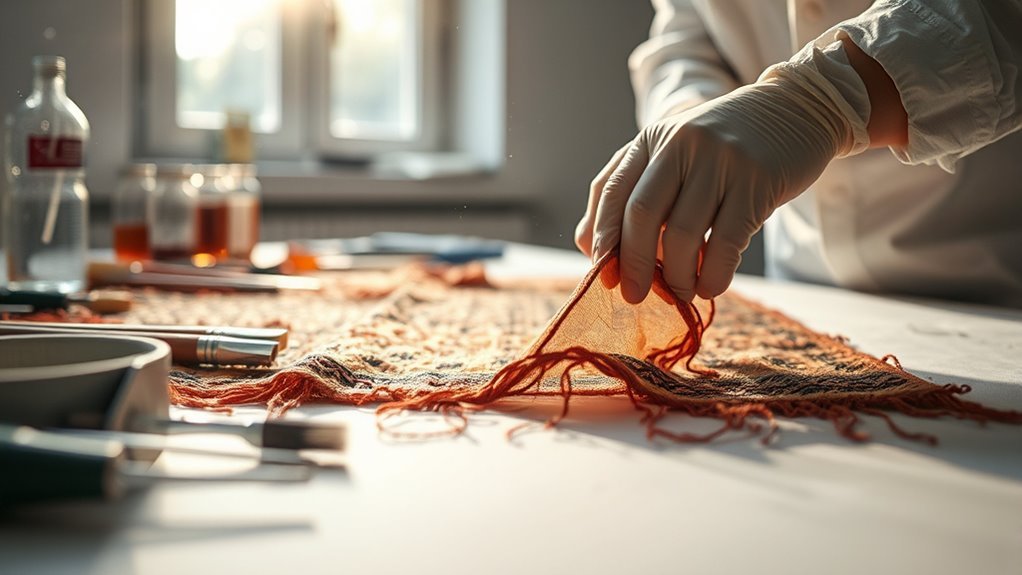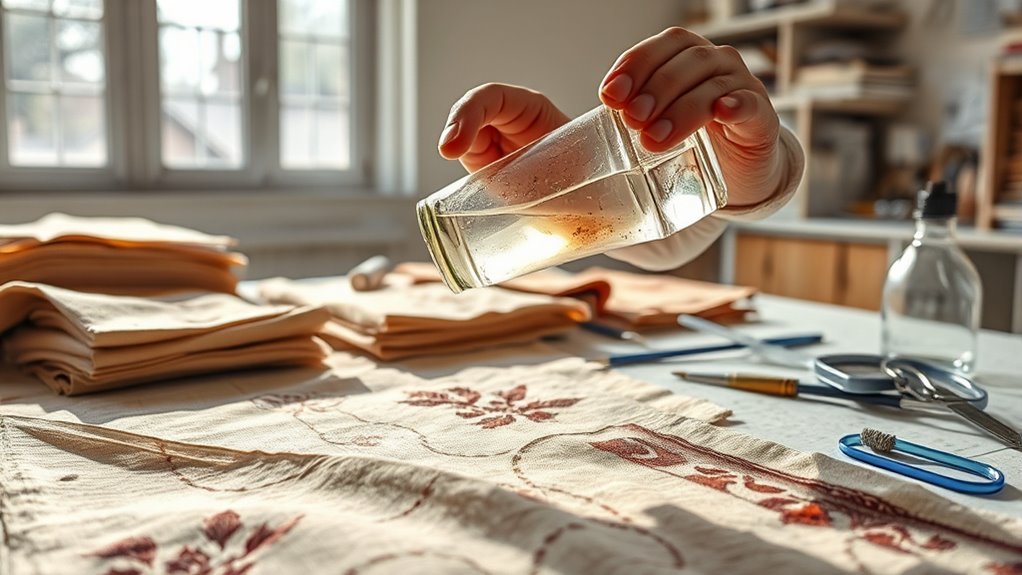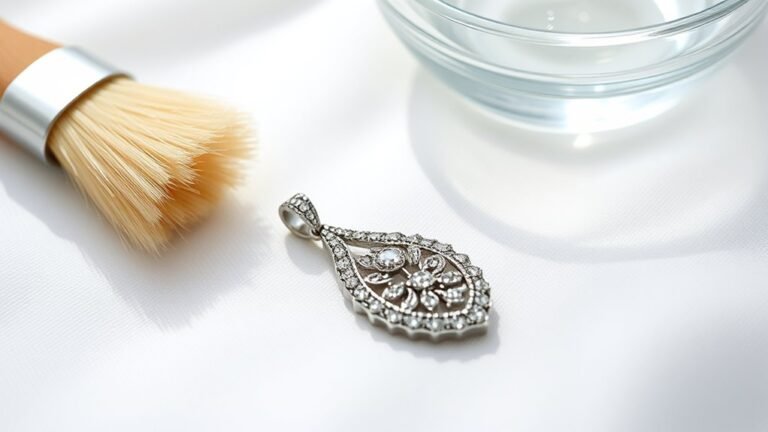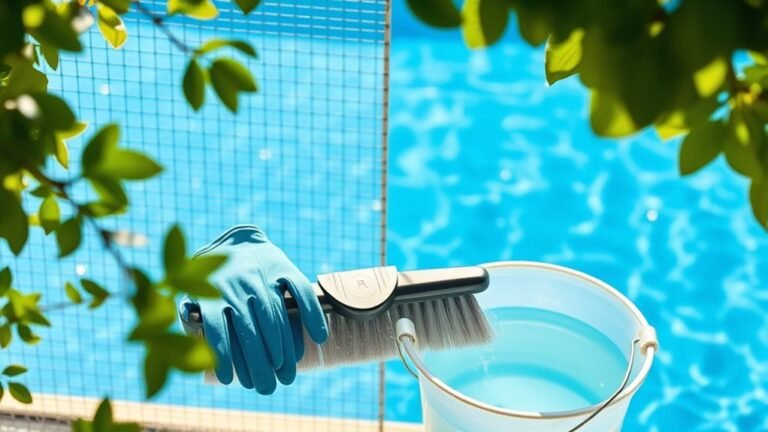Advanced Techniques for Cleaning Historic Textiles
When cleaning historic textiles, you’ll want to use gentle aqueous methods with pH-neutral agents and distilled water to protect fragile fibers. Enzyme-based treatments target specific stains without harsh chemicals, while laser cleaning offers precise, non-abrasive dirt removal that preserves original colors. Combining microfiber cloths and ultrasonic tools enhances safety and effectiveness. Before starting, always test and monitor environmental conditions like humidity and temperature. If you’re aiming to preserve textile integrity, exploring these techniques can transform your approach.
Understanding the Challenges of Historic Textile Cleaning

Although historic textiles often hold immense cultural and sentimental value, cleaning them presents unique challenges you won’t find with modern fabrics. When you approach these pieces, you have to take into account their historical context—materials, dyes, and craftsmanship that may be centuries old. These factors make cleaning a delicate task because what works for new textiles could damage fragile fibers or erase original colors. You’ll face cleaning challenges like brittleness, sensitivity to moisture, and previous restoration attempts that complicate your work. Understanding these specifics lets you respect the textile’s story while preserving its integrity. By recognizing the distinct nature of historic textiles, you gain the freedom to clean thoughtfully, ensuring these treasures endure for future generations without losing their soul.
The Role of Gentle Aqueous Cleaning Methods
When you’re working with delicate fabrics, gentle aqueous cleaning methods can make all the difference. Using mild solutions helps protect fibers while effectively removing dirt and stains. Let’s explore the best techniques to keep your textiles safe and fresh.
Benefits of Mild Solutions
Since harsh chemicals can damage delicate fabrics, mild solutions offer a safer alternative that preserves textile integrity while effectively removing dirt. When you choose mild solutions, you’re embracing conservation benefits that safeguard the textile’s longevity and color vibrancy. These gentle methods minimize fiber stress and prevent irreversible damage, giving you freedom to restore without worry.
| Benefit | Description | Impact on Textiles |
|---|---|---|
| Fiber Preservation | Prevents weakening or breaking of fibers | Maintains strength |
| Color Retention | Protects original dyes from fading | Keeps colors vibrant |
| Reduced Residue | Leaves minimal chemical buildup | Avoids future degradation |
| Environmental Safety | Uses eco-friendly, biodegradable ingredients | Guarantees safer handling |
Using mild solutions lets you clean responsibly while respecting historic textiles’ delicate nature.
Techniques for Delicate Fabrics
Because delicate fabrics require extra care, gentle aqueous cleaning methods are your best choice for preserving their texture and appearance. These techniques respect fiber sensitivity, ensuring your historic textiles stay intact without harsh damage. You’ll want to select mild cleaning agents that won’t strip natural oils or weaken fibers.
Consider these essential steps when handling delicate fabrics:
- Use distilled water to avoid mineral deposits and reduce risk of discoloration.
- Opt for pH-neutral, biodegradable cleaning agents designed specifically for sensitive textiles.
- Gently agitate textiles by hand rather than machine washing to minimize stress on fibers.
- Rinse thoroughly with cool water to remove all residues without shocking the fabric.
Utilizing Enzyme-Based Treatments for Stain Removal

When tackling tough stains, enzyme-based treatments can be a game-changer by breaking down proteins, fats, and starches. You’ll want to understand the different enzyme types and how to apply them correctly for the best results. Just remember to follow safety precautions to protect both your textiles and yourself.
Enzyme Types Overview
Enzymes are powerful agents you’ll find in many cleaning products designed for textiles, especially when tackling stubborn stains. Understanding enzyme types helps you choose treatments that maximize enzyme efficacy and broaden enzyme applications. Here are key enzyme categories to ponder:
- Proteases: Target protein-based stains like blood or sweat, breaking them down efficiently.
- Amylases: Focus on starches and carbohydrate residues, ideal for food-related stains.
- Lipases: Work on fats and grease, dissolving oily deposits on fabric.
- Cellulases: Gently remove microfibrils and brighten cotton, enhancing fabric texture.
Application Techniques
Although enzyme-based treatments are highly effective, knowing how to apply them correctly guarantees you get the best stain removal results. Start by selecting the right enzyme for the stain type—protease for protein stains or lipase for fats. Apply the treatment gently, using a soft brush or spray bottle, ensuring even coverage without oversaturating the fabric. Let the enzymes work by incubating the textile at room temperature, typically 15-30 minutes, but avoid letting it dry out. Rinse thoroughly with cool water to stop enzyme activity and remove residues. These application techniques are essential in your cleaning strategies, allowing you to tackle stubborn stains while preserving delicate fibers. Mastering these steps gives you freedom to restore textiles effectively without risking damage.
Safety Precautions
Because enzyme-based treatments involve active biological agents, you’ll need to take certain safety precautions to protect yourself and your textiles. Handling these treatments without care can lead to unwanted chemical exposure or damage to delicate fibers. To maintain your freedom and guarantee safe use, keep these tips in mind:
- Always wear personal protective equipment like gloves and goggles to minimize skin and eye contact.
- Work in a well-ventilated area to reduce inhalation risks.
- Test the treatment on a small, inconspicuous textile area first to avoid irreversible damage.
- Store enzyme solutions securely, away from children and pets, to prevent accidental exposure.
Laser Cleaning Technology in Textile Conservation

Laser cleaning technology offers a precise and effective way to remove dirt and contaminants from delicate textiles without causing damage. When you use laser precision, you target only the unwanted layers, preserving the fabric’s integrity and original colors. This method aligns perfectly with conservation ethics, ensuring you respect the textile’s history while restoring its appearance. You’ll appreciate how this technique gives you control—adjusting intensity and focus to suit each unique piece. Unlike traditional methods, laser cleaning doesn’t rely on harsh chemicals or physical abrasion, giving you the freedom to work safely with fragile, historic materials. By embracing laser technology, you’re not just cleaning textiles; you’re honoring their story and extending their life for future generations to experience.
The Application of Solvent-Based Cleaning Techniques
While laser cleaning offers a high-tech approach to textile conservation, solvent-based techniques remain a valuable option when dealing with certain stains and residues. When you choose solvents, you need to take into account solvent selection carefully to guarantee fabric compatibility. Not all fabrics respond well to every solvent, so testing is essential before full application. Solvent cleaning lets you target specific contaminants without soaking the entire textile.
Remember these key points:
- Evaluate the type of stain or residue before selecting a solvent
- Assess the textile’s fiber and weave for solvent tolerance
- Use minimal solvent quantities to avoid overexposure
- Always test on a small, inconspicuous area first
Controlled Humidity and Temperature in Textile Cleaning
You’ll need to maintain ideal humidity levels to prevent damage during cleaning. Temperature plays an essential role, as it can affect the fibers’ integrity. Monitoring and adjusting these conditions guarantees the best results for your textiles.
Ideal Humidity Levels
How does humidity affect the cleaning of textiles? When you manage humidity control effectively, you prevent damage caused by excess moisture or dryness. Ideal humidity levels allow fibers to maintain their natural balance, which is essential during cleaning. For precise moisture management, aim for:
- Maintaining relative humidity between 45% and 55%
- Avoiding rapid fluctuations to prevent fiber stress
- Using humidifiers or dehumidifiers as needed
- Monitoring humidity with reliable instruments consistently
Temperature Impact on Fibers
Controlling humidity is only part of the equation when you’re cleaning textiles; temperature plays a significant role in how fibers respond during the process. You need to balance warmth carefully—too high, and you risk thermal degradation that weakens the fabric’s structure. Maintaining moderate temperatures preserves fiber resilience, allowing the textile to withstand cleaning without losing its integrity. When fibers heat up excessively, their proteins and cellulose can break down, leading to irreversible damage. By keeping temperatures steady and appropriate for the specific textile type, you protect its original strength and flexibility. This freedom to control temperature means you can clean effectively without sacrificing the longevity of your historic textiles. Understanding this balance empowers you to treat your pieces with the care they deserve.
Monitoring and Adjustments
Although maintaining the right temperature and humidity levels is essential, actively monitoring and adjusting these conditions during textile cleaning guarantees the best results. You’ll want to employ effective monitoring techniques to keep a close eye on the environment surrounding your textiles. With precise adjustment strategies, you can swiftly respond to any fluctuations that might compromise the fabric’s integrity. Consider these key approaches:
- Use digital hygrometers and thermometers for real-time data.
- Implement automated climate control systems to maintain stability.
- Regularly calibrate your monitoring devices for accuracy.
- Adjust ventilation and humidification based on fabric sensitivity.
Microfiber and Ultrasonic Cleaning Tools
Microfiber and ultrasonic cleaning tools have revolutionized the way you maintain textiles, offering efficiency and gentleness that traditional methods often lack. With microfiber benefits, you get superior dirt and dust removal without harsh chemicals, preserving your historic textiles’ integrity while granting you freedom from abrasive scrubbing. Ultrasonic efficiency takes cleaning a step further by using high-frequency sound waves to penetrate fibers, loosening embedded grime safely and thoroughly. This technology lets you refresh delicate fabrics without soaking or mechanical agitation, so you avoid damage while enjoying a deeper clean. By integrating these tools into your routine, you gain control and precision, protecting your cherished textiles while embracing modern innovation. These methods empower you to care for your collection with confidence and ease.
Safety Measures and Testing Before Cleaning
Before you start cleaning any textile, it’s crucial to perform safety checks and tests to prevent damage. Following proper safety protocols guarantees you protect both the fabric and yourself. Employing effective testing methods lets you understand the textile’s condition and how it will react to cleaning agents.
Perform essential safety checks and tests before cleaning textiles to protect both fabric and yourself.
Consider these key steps before proceeding:
- Conduct a patch test on an inconspicuous area to check for colorfastness.
- Inspect for weak fibers or damage that could worsen during cleaning.
- Verify any historical treatments or materials that might react adversely.
- Use appropriate personal protective equipment to handle chemicals safely.
Case Studies of Successful Textile Conservation
Once you’ve guaranteed safety and tested your textiles, you can appreciate the impact of careful conservation through real-world examples. Case studies reveal how meticulous cleaning techniques restored delicate fabrics without compromising their integrity. In one instance, a 19th-century silk tapestry, once stained and fragile, regained its vibrancy after a tailored treatment, showcasing conservation success that balanced preservation with aesthetic revival. Another case study involved a historic quilt, where gentle wet cleaning removed years of grime, allowing its intricate patterns to shine anew. These stories prove that with patience and expertise, you can revive textiles while respecting their past. Embracing these successes inspires confidence, letting you approach your own projects with freedom, knowing that thoughtful conservation can truly make a difference.
Future Innovations in Textile Cleaning Technology
As textile conservation advances, you’ll see innovative cleaning technologies transforming how delicate fabrics are preserved. Future innovations focus on combining smart cleaning with sustainable practices, giving you greater control and minimizing environmental impact. You can expect breakthroughs such as:
- AI-driven sensors that adjust cleaning intensity based on fabric condition
- Eco-friendly solvents derived from natural sources, reducing chemical waste
- Ultrasonic cleaning methods that target dirt without harsh agitation
- Real-time monitoring systems ensuring ideal preservation settings
These technologies empower you to protect historic textiles with precision and care, while supporting a greener future. Embracing these advancements means you’re not just maintaining artifacts—you’re championing freedom in conservation, balancing respect for the past with responsibility toward the environment.
Frequently Asked Questions
How Do Cleaning Techniques Vary for Different Historical Textile Fibers?
Imagine holding a fragile fabric, its fibers whispering stories of the past. You’ll find cleaning natural fibers like cotton or silk demands gentle care, often using mild detergents and controlled moisture to avoid damage. Synthetic fibers, however, can handle a bit more robust treatment but still require caution to preserve their integrity. Your freedom lies in choosing the right method—balancing preservation with thorough cleaning, so each textile’s history stays alive and vibrant.
What Are the Environmental Impacts of Textile Cleaning Chemicals?
When you’re cleaning textiles, the chemicals used can harm the environment by polluting water and soil. You’ll want to choose sustainable alternatives that minimize this impact. Look for products with high chemical biodegradability, so they break down naturally without leaving toxic residues. By doing this, you not only protect the planet but also enjoy the freedom of knowing your cleaning methods align with eco-friendly values, keeping both history and nature safe.
How Often Should Historic Textiles Be Cleaned for Preservation?
Like tending a delicate garden, you shouldn’t overdo it—historic textiles need gentle care, not constant cleaning. The ideal cleaning frequency is minimal, only when necessary, to avoid wear and chemical damage. Following preservation best practices means inspecting textiles regularly and cleaning them sparingly, preserving their freedom to age gracefully. Remember, less is more; your restraint helps these treasures survive for generations without losing their essence or charm.
Can Cleaning Methods Affect Textile Dyes or Colors Long-Term?
Yes, cleaning methods can definitely affect dye stability in textiles over time. If you’re not careful, harsh chemicals or improper washing might cause fading or color bleeding. That’s why colorfastness testing is essential before any cleaning—you want to make sure the dyes won’t run or fade. By understanding how your textile’s dyes react, you can preserve its vibrant colors and keep its story alive for years to come.
What Training Is Required for Conservators Handling Historic Textiles?
Imagine holding history in your hands—each thread a story. To handle such treasures, you’ll need solid training grounded in conservation ethics, ensuring respect for the past while preserving it for the future. You’ll immerse yourself in practical workshops that teach delicate cleaning, stabilization, and documentation techniques. This blend of knowledge and hands-on experience gives you the freedom to protect historic textiles responsibly without compromising their soul.






